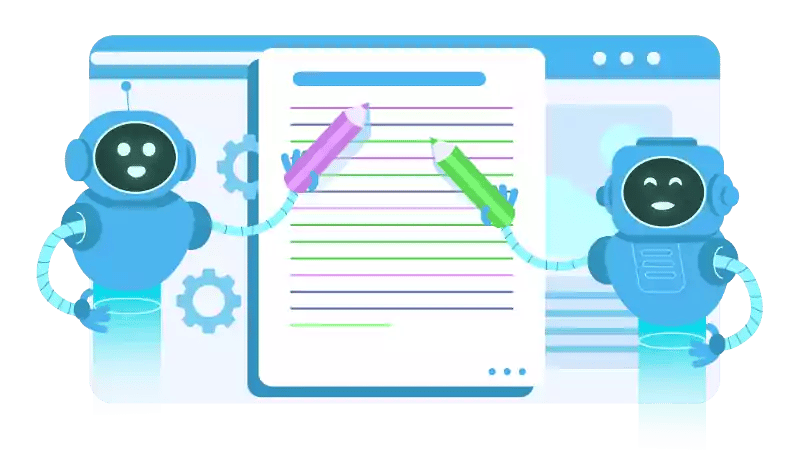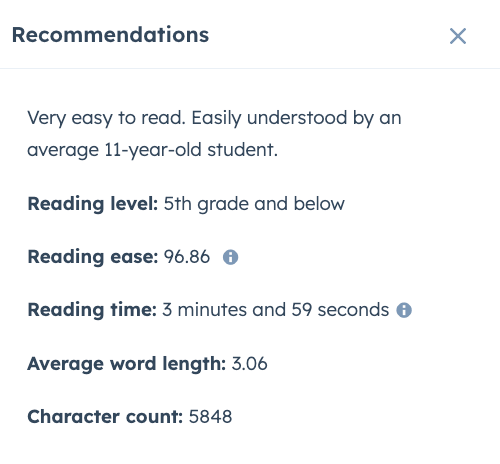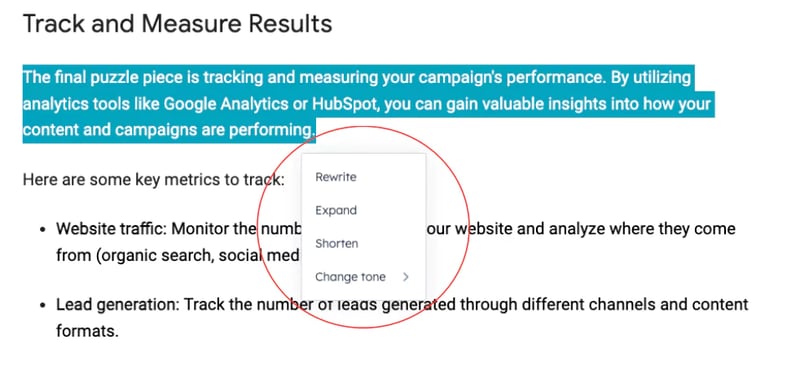Is Your Content Easy to Read? What Level Should It Be?
Ever spend hours crafting the perfect marketing message, only to hear crickets? Your content might be brilliant, but if it reads like a college textbook, your audience will glaze over faster than you can say "engagement." This is where readability level comes in. It's the key to unlocking clear communication, the golden ticket to having your content truly connect and resonate with readers.

Why Does Readability Matter?
In the age of information overload, capturing and retaining attention is a constant battle for marketers. Crafting the perfect message is useless if your audience gets lost in convoluted sentences and complex jargon. This is where the readability level comes into play. It's about ensuring your content is easily understood and engaging, leading to better marketing outcomes. Here's how clear communication translates to success:
Improved Engagement and Conversions
Imagine you're scrolling through endless social media feeds, bombarded with information. Suddenly, a clear, concise message grabs your attention. You find yourself reading further, intrigued by the easy flow of words and the simplicity of the message. This is the power of readable content. It hooks your audience, allowing them to digest information effortlessly. This translates to increased engagement: more reading time, greater interaction with your content, and a deeper understanding of your message.
Furthermore, clear communication leads to improved conversions. When readers comprehend your message effortlessly, they are more likely to take the desired action, whether it's subscribing to your newsletter, downloading a white paper, or making a purchase. Think of it like a call to action: the easier it is to understand the call, the more likely people are to answer.
Enhanced Brand Image and Trust
Complex language and jargon might create an air of sophistication, but it often creates a barrier between your brand and your audience. Readable content, on the other hand, fosters transparency and accessibility. It shows your audience that you value their time and understanding and are confident in your message without resorting to unnecessary complexity. This fosters a sense of trust and credibility, positioning your brand as reliable and approachable.
Furthermore, clear communication demonstrates respect for your audience's intelligence. They don't need to be talked down to or overwhelmed with technical terms. This fosters positive brand perception, making your audience more likely to see your brand as trustworthy and reliable.
Wider Audience Reach and Accessibility
Not everyone has the same reading comprehension level, and diverse audiences are a reality for most brands today. Readable content caters to a broader audience, ensuring your message reaches a wider range of potential customers, regardless of their educational background or reading level. This translates to increased brand awareness and market penetration.
Moreover, clear communication is inclusive and accessible to individuals with learning disabilities or those who may not speak English as their first language. By simplifying your writing, you ensure everyone has the opportunity to understand your message and engage with your brand. This demonstrates a commitment to inclusivity and fosters positive brand associations.
Clear and concise content isn't just about aesthetics; it's about strategic communication that delivers tangible benefits. By prioritizing readability, you improve audience engagement, enhance brand image, and reach a wider audience, propelling your marketing efforts toward greater success.
Understanding Readability Levels
You may be thinking: I can understand my writing, but how do I know if it's easy for others to understand, too? Enter readability metrics: a set of tools designed to quantify the complexity of your writing. These metrics offer valuable insights and help you tailor your content to the reading level of your target audience.
There are two common readability metrics:
-
Flesch-Kincaid Grade Level: This popular metric assigns your text a grade level equivalent (e.g., 8th grade) based on factors like sentence length and syllable count. Generally, a lower grade level indicates easier reading.
-
Gunning Fog Index: Similar to the Flesch-Kincaid score, the Gunning Fog Index considers sentence length and complexity (based on an average number of words per sentence and the percentage of complex words with three or more syllables). A lower score signifies easier reading comprehension.
While these formulas provide a numerical score, it's important to remember that they are estimates, not absolute measurements. They don't account for factors like cultural understanding, tone, and the specific context of your writing.
Tailoring Readability to Your Audience
Knowing your target audience is the golden rule in marketing, and it applies equally to creating relevant content. Understanding who you're writing for helps you strike the right balance between informative and engaging, ultimately leading to a higher impact.
So, how does the target audience play into choosing the right reading level? Imagine trying to explain complex financial concepts to a child using sophisticated vocabulary. It's likely to go over their head and leave them lost. Similarly, bombarding a highly educated audience with basic language might feel condescending and fail to capture their attention.
That's why tailoring the reading level to your audience's expectations and comprehension is crucial. Generally, aiming for a reading level of 5th grade or below is ideal for most marketing content.
At Aspiration Marketing, we aim for our writing to be geared towards this reading level. We find that a fifth-grade level is easy for most of our audience to understand, especially considering that we target a geographically diverse audience, so English isn't always everyone's first language.
This recommendation stems from two main reasons:
-
Accessibility: A lower reading level ensures your message reaches a wider audience, regardless of their educational background or reading fluency. This is especially important for brands seeking to connect with diverse audiences.
-
Engagement: Simpler language is easier to understand and digest, leading to increased engagement with your content. Readers are more likely to stay engaged and retain information when it's presented in a clear and concise way.
However, it's important to remember that "5th grade or below" is a general guideline, not a rigid rule.
Here's why testing and adjusting are vital:
-
Content type: A technical white paper geared towards industry professionals might require a higher reading level than a social media post targeting a general audience.
-
Target audience insights: If you have specific data about your audience's demographics and educational background, you can tailor the reading level accordingly.
-
Testing and analysis: Tools like A/B testing can help you compare the performance of content written at different reading levels and determine what resonates best with your audience.
HubSpot has some excellent tips and even real-time recommendations if you're struggling to get your writing to this level. Consider the following:
-
Target your audience: Understand your ideal reader's reading level and preferences. Aim for content that resonates with them and aligns with their expectations.
-
Prioritize clarity: Use simple language, avoid jargon, and ensure your message is easy to understand.
-
Break up complex information: Use bullet points, subheadings, and visuals to break down complex concepts into bite-sized chunks.
-
Vary sentence length: Don't fall into the trap of monotonous sentence structure. Mix short and long sentences to create a natural flow.
-
Write naturally: Avoid forced conversationalism or overly formal language. Aim for a genuine and authentic voice that connects with your audience.
If you're writing in HubSpot, the platform will automatically generate these recommendations and review your writing:

We want to reiterate that context matters. A technical white paper aimed at industry professionals might require a higher reading level compared to a general blog (like this) written to help readers understand a new topic or idea.
If you need more assistance than these tips, HubSpot's AI assistant can help you clarify, condense, and generate content.
Or, with a simple prompt, you can request the assistant to generate content aligned with your desired reading level.
Tools for Measuring Readability
So, you understand the importance of clear communication and the need to tailor your content to your target audience. But how do you ensure your writing is hitting the mark? This is where readability measurement tools come in handy.
There are freely available online resources that analyze your writing and provide insights into its complexity, helping you identify areas for improvement. While not replacements for your own judgment, these tools offer valuable guidance to ensure your message is clear and easy to understand.
Here's a glimpse into some popular options:
-
Hemingway Editor: This user-friendly tool highlights complex sentences, adverbs, and passive voice. It assigns a color code (green being simplest, red being most complex) to different sections, making it visually easy to identify potential trouble spots.
-
Flesch-Kincaid Grade Level: This tool calculates the grade level equivalent of your writing, offering a general idea of the reading comprehension required to understand it.
-
Yoast SEO readability analysis: This plugin, primarily used for optimizing content for search engines, also includes a readability analysis feature. It provides suggestions for improving sentence length, sentence structure, and the use of passive voice.
Remember, these tools aren't meant to dictate your writing style but rather to guide you in creating clear and concise content. Here's how to interpret their results and use them to your advantage:
-
Focus on the big picture: Don't get bogged down by achieving a specific score. Use the feedback to identify areas where your writing might be overly complex or difficult to understand.
-
Address highlighted areas: Pay attention to sentences marked as complex, excessive adverbs, and passive voice usage. Consider restructuring sentences, replacing jargon with simpler terms, and using active voice for a more engaging flow.
-
Read your content aloud: This simple practice can help you identify awkward phrasing or areas that might confuse readers. Hearing yourself read can reveal hidden complexities you might miss while reading silently.
Remember, instead of solely focusing on achieving a specific score, use readability tools as guides to identify areas for improvement and ensure your content is understandable for your target audience. The goal is to communicate effectively, not to achieve the "perfect" score.
Checklist for Easily Readable Content
-
Target your audience: Who are you writing for? Tailor your language and complexity to their expectations and knowledge level.
-
Aim for clarity: Use simple language, avoid jargon, and ensure your message is easy to understand.
-
Break it down: Break down complex information into bite-sized chunks using bullet points, subheadings, and visuals.
-
Vary your sentences: Mix short and long sentences for a natural flow.
-
Read it aloud: Does it sound smooth and natural? This helps identify awkward phrasing.
-
Focus on active voice: Active voice makes your writing more engaging and easier to follow.
-
Use transition words: Smooth transitions between sentences improve readability and flow.
-
Proofread and edit: Ensure your content is free of grammatical errors and typos.
-
Measure readability: Use online tools like Hemingway Editor or Flesch-Kincaid to get an indication of complexity. Remember, these are guides, not absolutes.
-
Test and adjust: Experiment with different approaches and see what resonates best with your audience.
By following these tips and using your judgment, you can create good, informative, and engaging content for your audience.
Clear Communication: The Cornerstone of Content Marketing
Readability has a huge impact on content marketing success. Clear communication fosters engagement, builds trust, and expands your reach, propelling your brand forward.
It's important to ensure consistent clarity in your writing, so consider setting internal guidelines for you or your team, like targeting a specific grade level and minimum reading ease score (to be determined based on further analysis).
If you need more help simplifying your content, getting content in front of your audience, or creating content altogether, consider partnering with Aspiration Marketing for our content marketing services!
This content is also available in:
- Deutsch: Ist Ihr Inhalt leicht zu lesen? Welches Niveau sollte er haben?
- Español: ¿Es su contenido fácil de leer? ¿Qué nivel debe tener?
- Français: Votre contenu est-il facile à lire ? À quel niveau doit-il se situer ?
- Italiano: Contenuto leggibile: a che livello?
- Română: Conținut ușor de citit? La ce nivel ar trebui să fie?
- 简体中文: 您的内容是否易于阅读?应该达到什么程度?












Leave a Comment